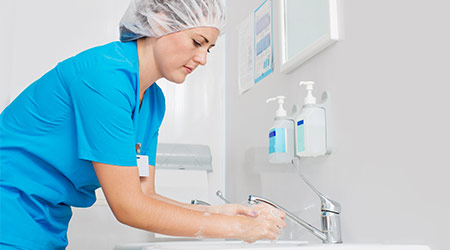Facility managers in healthcare facilities battling the COVID-19 pandemic have been preoccupied with such complex challenges as upgrading HVAC systems and preparing for vaccine distribution. At the same time, however, managers need to remain vigilant on a more basic but equally critical measure to control the illness — handwashing.
Care avoidance due to fear of exposure to COVID-19 poses a significant threat to hospital profitability, according to Fierce Healthcare. It has arguably never been more important to restore patient and staff confidence in infection-prevention measures put in place to keep everyone safe.
When COVID-19 hit, the infection prevention team at North Memorial Health, a 353-bed hospital and Level I trauma center in Robbinsdale, Minnesota, officials assessed the emerging infection prevention needs related to the pandemic and identified a plan, including handwashing. Hand hygiene was cited, early on, by the Centers for Disease Control and Prevention and others as one of the most important practices to reduce the spread of COVID-19.
Hand hygiene compliance has long been a challenge in healthcare. Various studies have shown that when staff are rushed and focused on imminent patient care needs, hand hygiene compliance can slip. While many hospitals believe they’re achieving 90 percent compliance, studies show average hand hygiene compliance is actually less than 40 percent.
In February 2019 — one year prior to COVID-19’s arrival in the U.S. — the hospital implemented an electronic hand hygiene compliance monitoring system hospitalwide. As a result of that implementation, officials are confident they have achieved and sustained 90 percent hand hygiene compliance rates on an ongoing basis, and its rate of hospital-acquired infections dropped.
Click here to read the article.

 Building Disaster Resilience Through Collaboration
Building Disaster Resilience Through Collaboration Amae Health Expands to New York City
Amae Health Expands to New York City Hospital for Special Surgery Opens Two New Facilities in New Jersey
Hospital for Special Surgery Opens Two New Facilities in New Jersey Should We Be Testing Toilet Water in Patient Restrooms?
Should We Be Testing Toilet Water in Patient Restrooms? Healthcare Union Petitions for Increased Staff Safety at HCA Florida Hospitals
Healthcare Union Petitions for Increased Staff Safety at HCA Florida Hospitals